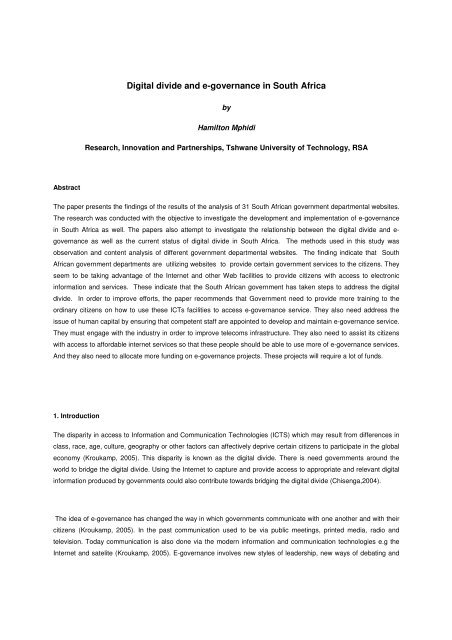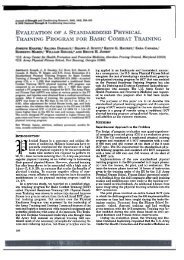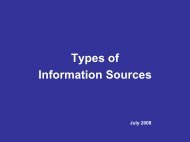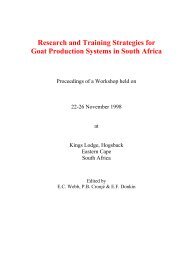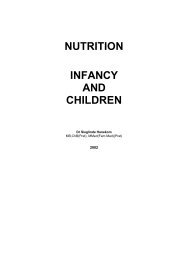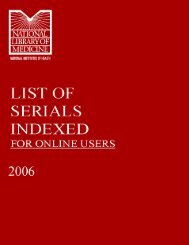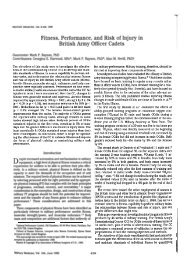Digital divide and e-governance in South Africa - Library
Digital divide and e-governance in South Africa - Library
Digital divide and e-governance in South Africa - Library
You also want an ePaper? Increase the reach of your titles
YUMPU automatically turns print PDFs into web optimized ePapers that Google loves.
Abstract<br />
<strong>Digital</strong> <strong>divide</strong> <strong>and</strong> e-<strong>governance</strong> <strong>in</strong> <strong>South</strong> <strong>Africa</strong><br />
by<br />
Hamilton Mphidi<br />
Research, Innovation <strong>and</strong> Partnerships, Tshwane University of Technology, RSA<br />
The paper presents the f<strong>in</strong>d<strong>in</strong>gs of the results of the analysis of 31 <strong>South</strong> <strong>Africa</strong>n government departmental websites.<br />
The research was conducted with the objective to <strong>in</strong>vestigate the development <strong>and</strong> implementation of e-<strong>governance</strong><br />
<strong>in</strong> <strong>South</strong> <strong>Africa</strong> as well. The papers also attempt to <strong>in</strong>vestigate the relationship between the digital <strong>divide</strong> <strong>and</strong> e-<br />
<strong>governance</strong> as well as the current status of digital <strong>divide</strong> <strong>in</strong> <strong>South</strong> <strong>Africa</strong>. The methods used <strong>in</strong> this study was<br />
observation <strong>and</strong> content analysis of different government departmental websites. The f<strong>in</strong>d<strong>in</strong>g <strong>in</strong>dicate that <strong>South</strong><br />
<strong>Africa</strong>n government departments are utiliz<strong>in</strong>g websites to provide certa<strong>in</strong> government services to the citizens. They<br />
seem to be tak<strong>in</strong>g advantage of the Internet <strong>and</strong> other Web facilities to provide citizens with access to electronic<br />
<strong>in</strong>formation <strong>and</strong> services. These <strong>in</strong>dicate that the <strong>South</strong> <strong>Africa</strong>n government has taken steps to address the digital<br />
<strong>divide</strong>. In order to improve efforts, the paper recommends that Government need to provide more tra<strong>in</strong><strong>in</strong>g to the<br />
ord<strong>in</strong>ary citizens on how to use these ICTs facilities to access e-<strong>governance</strong> service. They also need address the<br />
issue of human capital by ensur<strong>in</strong>g that competent staff are appo<strong>in</strong>ted to develop <strong>and</strong> ma<strong>in</strong>ta<strong>in</strong> e-<strong>governance</strong> service.<br />
They must engage with the <strong>in</strong>dustry <strong>in</strong> order to improve telecoms <strong>in</strong>frastructure. They also need to assist its citizens<br />
with access to affordable <strong>in</strong>ternet services so that these people should be able to use more of e-<strong>governance</strong> services.<br />
And they also need to allocate more fund<strong>in</strong>g on e-<strong>governance</strong> projects. These projects will require a lot of funds.<br />
1. Introduction<br />
The disparity <strong>in</strong> access to Information <strong>and</strong> Communication Technologies (ICTS) which may result from differences <strong>in</strong><br />
class, race, age, culture, geography or other factors can affectively deprive certa<strong>in</strong> citizens to participate <strong>in</strong> the global<br />
economy (Kroukamp, 2005). This disparity is known as the digital <strong>divide</strong>. There is need governments around the<br />
world to bridge the digital <strong>divide</strong>. Us<strong>in</strong>g the Internet to capture <strong>and</strong> provide access to appropriate <strong>and</strong> relevant digital<br />
<strong>in</strong>formation produced by governments could also contribute towards bridg<strong>in</strong>g the digital <strong>divide</strong> (Chisenga,2004).<br />
The idea of e-<strong>governance</strong> has changed the way <strong>in</strong> which governments communicate with one another <strong>and</strong> with their<br />
citizens (Kroukamp, 2005). In the past communication used to be via public meet<strong>in</strong>gs, pr<strong>in</strong>ted media, radio <strong>and</strong><br />
television. Today communication is also done via the modern <strong>in</strong>formation <strong>and</strong> communication technologies e.g the<br />
Internet <strong>and</strong> satelite (Kroukamp, 2005). E-<strong>governance</strong> <strong>in</strong>volves new styles of leadership, new ways of debat<strong>in</strong>g <strong>and</strong>
decid<strong>in</strong>g policy <strong>and</strong> <strong>in</strong>vestment, new ways of access<strong>in</strong>g education, new ways of listen<strong>in</strong>g to citizens <strong>and</strong> new ways of<br />
organis<strong>in</strong>g <strong>and</strong> deliver<strong>in</strong>g <strong>in</strong>formation <strong>and</strong> services (Tlagadi, 2007).<br />
Accord<strong>in</strong>g to Chisenga (2004) government <strong>in</strong> <strong>Africa</strong> are the major producers of public <strong>in</strong>formation <strong>and</strong> could therefore<br />
contribute to bridg<strong>in</strong>g the digital <strong>divide</strong> by mak<strong>in</strong>g <strong>in</strong>formation available to their citizens via the Internet. Governments<br />
<strong>in</strong> developed <strong>and</strong> develop<strong>in</strong>g countries are mak<strong>in</strong>g <strong>in</strong>creas<strong>in</strong>g use of electronic to <strong>in</strong>teract <strong>and</strong> communicate with<br />
another <strong>and</strong> with their citizens to deliver more effective services (Kroukamp, 2005; Mnjama & Wamukoya, 2007).<br />
Internet is chang<strong>in</strong>g the way people live today. This implies that more <strong>and</strong> more people will rely on the Internet for<br />
<strong>in</strong>formation. Therefore if government has to reach out to this Internet population, they have to put their <strong>in</strong>formation<br />
<strong>and</strong> activities on the Internet via the websites.<br />
<strong>Digital</strong> <strong>divide</strong> is def<strong>in</strong>ed as by Cullen (2003: 247) as the metaphor use to describe the perceived disadvantage of<br />
those who either are unable or do not choose to make use of ICT <strong>in</strong> their daily life. The <strong>Digital</strong> Divide Network (2004)<br />
def<strong>in</strong>es the concept as the gap between those who have access to communication tools, such as the Internet <strong>and</strong><br />
those who cannot.<br />
The American <strong>Library</strong> Association (ALA), Office for Information Technology Policy (2000) def<strong>in</strong>es the digital <strong>divide</strong> as<br />
disparities based on economic, status, gender, race, physical abilities <strong>and</strong> geographic location between those who<br />
have or do not have access to <strong>in</strong>formation, the Internet <strong>and</strong> other <strong>in</strong>formation technologies <strong>and</strong> services. Mariscal<br />
(2005:410) def<strong>in</strong>es the concept as the gap between <strong>in</strong>dividuals, households, bus<strong>in</strong>ess <strong>and</strong> geographic arrears at<br />
different socio-economic levels with regard both to their opportunities to access <strong>in</strong>formation technologies <strong>and</strong> to the<br />
use of such technologies for a wide variety of activities.<br />
E-government refers to the use of Information <strong>and</strong> Communication Technologies (ICTs) to improve the efficiency,<br />
effectiveness, operations, service delivery <strong>and</strong> accountability of government (The World Bank, 2006 as cited <strong>in</strong> S<strong>in</strong>gh<br />
& Sahu, 2008; Kumar & Best, 2006; Kroukamp, 2005; Saxena, 2005; Turban et al, 2004). E-<strong>governance</strong> has evolved<br />
an <strong>in</strong>formation-age model of <strong>governance</strong> that seeks to realize processes <strong>and</strong> structures for harness<strong>in</strong>g the<br />
potentialities of <strong>in</strong>formation <strong>and</strong> communication technologies (ICTs) (Saxena, 2005).<br />
For the purpose of this paper e-<strong>governance</strong> will be def<strong>in</strong>ed as public sector’s use of <strong>in</strong>formation <strong>and</strong> communication<br />
technologies with the aim of improv<strong>in</strong>g <strong>in</strong>formation <strong>and</strong> service delivery, encourag<strong>in</strong>g citizen participation <strong>in</strong> the<br />
decision-mak<strong>in</strong>g process <strong>and</strong> mak<strong>in</strong>g government more accountable, transparent <strong>and</strong> effective
The purpose of this paper is to provide a critical analysis on how <strong>South</strong> <strong>Africa</strong>n government is engaged <strong>in</strong> e-<br />
<strong>governance</strong> <strong>in</strong> order to improve operations <strong>and</strong> service delivery <strong>in</strong> the public sector. This will be dome by evaluat<strong>in</strong>g<br />
<strong>and</strong> analyz<strong>in</strong>g different websites of <strong>South</strong> <strong>Africa</strong>n government departments.<br />
2. <strong>South</strong> <strong>Africa</strong> <strong>and</strong> the digital <strong>divide</strong><br />
Just like many other countries, <strong>South</strong> <strong>Africa</strong> is also affected by the digital <strong>divide</strong>. In 1994 the new <strong>South</strong> <strong>Africa</strong> was<br />
born <strong>and</strong> great optimism <strong>and</strong> hope characterized the nation. This section will provide current state of the digital <strong>divide</strong><br />
<strong>in</strong> <strong>South</strong> <strong>Africa</strong>. In order to achieve that it will address the follow<strong>in</strong>g: current overview of <strong>South</strong> <strong>Africa</strong>, Internet usage,<br />
factors contribut<strong>in</strong>g to the digital <strong>divide</strong>, <strong>and</strong> attempts to bridge the digital <strong>divide</strong> <strong>in</strong> <strong>South</strong> <strong>Africa</strong>. Many people<br />
anticipated the new policies <strong>and</strong> firm measures of redness would contribute to the creation of a more equitable <strong>and</strong><br />
fair society that would enable <strong>South</strong> <strong>Africa</strong> to become a player <strong>in</strong> the global economy (Czerniewicz, 2004). What<br />
makes <strong>South</strong> <strong>Africa</strong> <strong>in</strong>terest<strong>in</strong>g <strong>in</strong> terms of the digital <strong>divide</strong> is the country’s multi ethnic <strong>and</strong> multi-l<strong>in</strong>gual profile. The<br />
cultural background of the people reflects the different mother tongues <strong>and</strong> language use of students<br />
(Guðmundsdóttir, 2005).<br />
<strong>South</strong> <strong>Africa</strong> is the fourth largest country <strong>in</strong> the Commonwealth <strong>and</strong> has the sixth largest population. With fifty per<br />
cent of its population <strong>in</strong> urban areas <strong>and</strong> has a highest rate of urbanization than most Sub-Saharan countries<br />
(Ak<strong>in</strong>sola; Herselman & Jacobs, 2005).<br />
Accord<strong>in</strong>g to Trusler (2003) <strong>South</strong> <strong>Africa</strong> has to deal with a number of challenges before they can beg<strong>in</strong> with any<br />
<strong>in</strong>itiatives for bridg<strong>in</strong>g the digital <strong>divide</strong>. They challenges issues are as follows Trusler (2003):<br />
A high level of <strong>in</strong>equality;<br />
A weak ICT <strong>in</strong>frastructure, particularly <strong>in</strong> rural areas;<br />
A lack of ICT read<strong>in</strong>ess <strong>in</strong> government<br />
More press<strong>in</strong>g dem<strong>and</strong>s <strong>in</strong> the public service that makes ICT development a lower priority <strong>in</strong> budget terms.<br />
ICT <strong>in</strong>dicators are used to measure how widely diffused <strong>and</strong> accessible (real access, profiled by proximity, language<br />
<strong>and</strong> cost) are ICTs across all regions <strong>and</strong> sectors of society. It further measures how ICT’s are be<strong>in</strong>g used by<br />
<strong>in</strong>dividuals, households, communities, government, the bus<strong>in</strong>ess sector <strong>and</strong> civil society to improve their livelihoods<br />
or operations (Lewis, 2007; SADoC, 2006). See Table 1.
Table 1: <strong>South</strong> <strong>Africa</strong>-ICT <strong>in</strong>dicators<br />
Indicators Number<br />
Population 47, 390, 900<br />
GDP USD 200.5 billion<br />
GDP per capita USD 4,230<br />
GINI co-efficient 57.8<br />
Ma<strong>in</strong> (fixed) telephone l<strong>in</strong>es 4,729,000<br />
Teledensity or Telephone subscribers (fixed) 9.9%<br />
No. of fixed l<strong>in</strong>e operators 2<br />
Mobile telephone subscribers 39,066,000<br />
Teledensity (mobile) 68.2%<br />
No. of mobile operators 3<br />
Internet subscribers (estimated) 5,100,000<br />
Broadb<strong>and</strong> <strong>in</strong>ternet subscribers 283,839<br />
No. of personal computers 5,300,000<br />
No. of <strong>in</strong>ternet service providers 355<br />
No. of television sets 10,000,000<br />
No of televisions stations 6<br />
No. of radio stations 130<br />
Sources: CIA (2007); ITU (2007); Lewis (2007); Telkom (2007); UNDP (2007); GCIS (2007); SADoC (2006); StatsSA<br />
(2007).<br />
<strong>South</strong> <strong>Africa</strong>n’s telephone <strong>in</strong>dustry has been historically separated <strong>in</strong>to fixed l<strong>in</strong>e <strong>and</strong> mobile cellular. The mobile<br />
telephone market <strong>in</strong> <strong>South</strong> <strong>Africa</strong> is substantially larger than fixed l<strong>in</strong>e services. See Table 2.1. Fixed l<strong>in</strong>e service<br />
providers are Telkom <strong>and</strong> Neo Tel, the later is enter<strong>in</strong>g market after been receiv<strong>in</strong>g its license <strong>in</strong> December 2005<br />
(i<strong>Africa</strong>, 2007; Lewis, 2007; ITU, 2007). Vodacom, MTN <strong>and</strong> Cell C are currently the only mobile communications<br />
service providers <strong>in</strong> <strong>South</strong> <strong>Africa</strong> (GCIS, 2007; Lewis, 2007).<br />
The UN Development Programme (INDP) currently ranks <strong>South</strong> <strong>Africa</strong> a lowly 121 st out of 177 countries, with a GINI<br />
co-efficient of 57.8, on its Human Development Index (UNDP, 2006). This represents a decl<strong>in</strong>e from 94 th out of 162<br />
countries <strong>in</strong> 2001, suggest<strong>in</strong>g the considerable challenges fac<strong>in</strong>g <strong>in</strong> improv<strong>in</strong>g the quality of life of its citizens (Lewis,<br />
2007).<br />
Prior to 1990, ICT services <strong>in</strong> <strong>South</strong> <strong>Africa</strong> were the sole responsibility of the state. Beg<strong>in</strong>n<strong>in</strong>g with broadcast<strong>in</strong>g,<br />
which is commissioned to the <strong>South</strong> <strong>Africa</strong>n Broadcast<strong>in</strong>g Corporation (SABC). <strong>South</strong> <strong>Africa</strong> has probably the slowest
fixed telecommunications, where the partially-privatised <strong>in</strong>cumbent, Telkom have a monopoly. Mobile<br />
telecommunications has seen rather more progress two mobile operators licensed <strong>in</strong> 1993 <strong>and</strong> a third <strong>in</strong> 2001 (Lewis,<br />
2007).<br />
3. The advantages of E-<strong>governance</strong><br />
There are many reasons <strong>and</strong> benefits of e-<strong>governance</strong> (Chisenga, 2004). The greatest advantage of e-<strong>governance</strong><br />
<strong>and</strong> its chief benefit to the society lies <strong>in</strong> its efficiency. Table 2 provides the advantages for e-<strong>governance</strong>.<br />
Table 2: Advantages of e-<strong>governance</strong><br />
Advantage Brief explanation Source (s)<br />
Cost effectiveness Reduce cost <strong>in</strong> render<strong>in</strong>g services Chisenga, 2004 Pardo, 2000;<br />
Time sav<strong>in</strong>g Reduc<strong>in</strong>g delays <strong>in</strong> delivery of<br />
services<br />
Improve communication communication between<br />
governments <strong>and</strong> citizens<br />
Improve operations <strong>and</strong> services Improv<strong>in</strong>g quality of service<br />
delivery<br />
exp<strong>and</strong> access Citizens access to Public Sector<br />
Re<strong>in</strong>force <strong>in</strong>novation<br />
Increase transparency <strong>and</strong> Public<br />
accountability<br />
Information<br />
Offers strong bonds between<br />
public <strong>and</strong> servants based on<br />
transparency <strong>and</strong> accountability<br />
Increase efficiency e-<strong>governance</strong> that produce more<br />
output at the same total cost <strong>in</strong><br />
less time<br />
Increase effectiveness Governance that works better:<br />
produc<strong>in</strong>g the same outputs at the<br />
same total cost <strong>in</strong> the same time,<br />
but to a higher quality st<strong>and</strong>ard.<br />
Heeks, 2001; Kumar & Best,<br />
2006; Kroukamp, 2005;Norris,<br />
2001; S<strong>in</strong>gh & Sahu, 2008<br />
Pardo, 2000; Heeks,2001; Kumar<br />
& Best, 2006; Norris, 2001<br />
Mokhele & De Beer<br />
Kumar & Best, 2006; S<strong>in</strong>gh &<br />
Sahu, 2008<br />
Chisenga,2004 Pardo, 2000;<br />
Heeks, 2001; Kumar & Best,<br />
2006; Kroukamp, 2005; Norris,<br />
2001<br />
Pardo, 2000; Heeks, 2001;<br />
Kumar & Best, 2006;Kroukamp,<br />
2005; Norris, 2001; Seifert &<br />
Bonham, 2003; Schware, 2000;<br />
S<strong>in</strong>gh & Sahu, 2008<br />
Kumar & Best, 2006;<br />
Kroukamp,2005; Tlagadi, 2007<br />
Kumar & Best, 2006; Tlagadi<br />
(2007)
E-<strong>governance</strong>, if implemented properly it can br<strong>in</strong>g all the benefits as <strong>in</strong>dicated <strong>in</strong> Table 2.<br />
4. Challenges of e-<strong>governance</strong><br />
Introduc<strong>in</strong>g e-<strong>governance</strong> can pose huge challenges to many governments. Difficulties can arise <strong>in</strong> the development,<br />
implementation <strong>and</strong> updat<strong>in</strong>g of e-government sites (Kroukamp, 2005; Tlagadi, 2007). Accord<strong>in</strong>g to Van Themaat<br />
(2004) the issue of e-government <strong>in</strong> <strong>South</strong> <strong>Africa</strong> is part of the country historical <strong>and</strong> social context <strong>and</strong> e-government<br />
<strong>in</strong>itiatives <strong>in</strong> the country therefore have to deal with number of challenges<br />
More serious challenges that can emanate from e-<strong>governance</strong> are <strong>in</strong>dicated as follows:<br />
4.1. Privacy:<br />
Many e-government systems collect, store <strong>and</strong> use the personal details of those who use their services or visits<br />
websites. That can pose a threat to <strong>in</strong>dividual privacy (Kroukamp, 2005)<br />
4.2. Security<br />
Governments will need to protect their <strong>in</strong>formation <strong>and</strong> systems from breaches of computer security that threaten not<br />
only the <strong>in</strong>tegrity <strong>and</strong> availability of services but also the confidence of users <strong>and</strong> the general public <strong>in</strong> the system<br />
(Kroukamp,2005).<br />
4.3. Economic disparities<br />
Accord<strong>in</strong>g to the Organisation for Economic Co-operation <strong>and</strong> Development (OECD, 2003) the economically<br />
disadvantaged have the lowest level of access to e-<strong>governance</strong> (Kroukamp, 2005; Van Themaat, 2004).<br />
4.4. Education<br />
Educated people are more likely to be the most user of the Internet. As the st<strong>and</strong>ard of education rises, so does use<br />
of the Internet (Kroukamp, 2005).<br />
4.5. Accessibility<br />
Ensur<strong>in</strong>g accessibility to all members of the society is essential. This must <strong>in</strong>clude <strong>in</strong>dividuals with disabilities to be<br />
able to use e-government websites (Kroukamp, 2005).<br />
4.6. Citizen awareness <strong>and</strong> confidence<br />
Creat<strong>in</strong>g awareness of the advantages of e-<strong>governance</strong> <strong>and</strong> persuad<strong>in</strong>g people to become users of the system are<br />
bigger challenges (Kroukamp, 2005).
4.7. Lack of leadership <strong>and</strong> management<br />
Political leadership which lacks the necessary drive to br<strong>in</strong>g about change <strong>in</strong> the public sector may be the biggest<br />
obstacle to development. Leaders who do not see e-government as priority pay little attention to ensur<strong>in</strong>g that IT<br />
policies <strong>and</strong> programmes are <strong>in</strong>troduced (Kroukamp, 2005).<br />
4.8. Bureaucratic government organization<br />
In many cases the flow of <strong>in</strong>formation between governments departments <strong>and</strong> agencies is developed <strong>and</strong> operated to<br />
meet the needs of government departments <strong>and</strong> agencies <strong>and</strong> not citizens (Kroukamp, 2005).<br />
4.9. IT impact<br />
People without access to ICT, would not be able to participate <strong>in</strong> the e-<strong>governance</strong> hence caus<strong>in</strong>g the domestic<br />
<strong>divide</strong>.<br />
4.10. Legal framework<br />
E-<strong>governance</strong> requires Legal Framework that supports <strong>and</strong> recognizes digital communication (Tlagadi, 2007).<br />
5. E-<strong>governance</strong> <strong>in</strong> <strong>South</strong> <strong>Africa</strong>: current situation<br />
S<strong>in</strong>ce 1994 the <strong>South</strong> <strong>Africa</strong>n government has launched a number of e-<strong>governance</strong> <strong>in</strong>itiatives, some <strong>in</strong>volv<strong>in</strong>g very<br />
advanced technology <strong>in</strong> order to <strong>in</strong>troduce e-<strong>governance</strong> (Kroukamp, 2005). <strong>South</strong> <strong>Africa</strong> has n<strong>in</strong>e (9) prov<strong>in</strong>ces <strong>and</strong><br />
each has its own Prov<strong>in</strong>cial legislature <strong>and</strong> Prov<strong>in</strong>cial Adm<strong>in</strong>istration. Each Prov<strong>in</strong>cial government has various<br />
departments responsible for various aspects of service delivery <strong>in</strong>clud<strong>in</strong>g health, social development <strong>and</strong> welfare<br />
services, education, agriculture <strong>and</strong> conservation, safety <strong>and</strong> security, transport, local government plann<strong>in</strong>g <strong>and</strong><br />
hous<strong>in</strong>g. Prov<strong>in</strong>cial departments are key agencies of service delivery (Mokhele & Deer, ). Kroukamp (2005) argues<br />
that although <strong>South</strong> <strong>Africa</strong> is ranked 65 th <strong>in</strong> the world <strong>and</strong> first on the <strong>Africa</strong>n cont<strong>in</strong>ent as far as e-<strong>governance</strong><br />
capacity concerned, such statistics do not reflect the fact that <strong>in</strong>frastructurally disadvantages areas, especially rural<br />
areas, have limited access to electricity <strong>and</strong> telephone l<strong>in</strong>es.<br />
Like other governments around the world, <strong>South</strong> <strong>Africa</strong>n Government is already <strong>in</strong> the process to improve service<br />
delivery <strong>and</strong> redress<strong>in</strong>g of the past (Mokhele & De Beer). All most all government departments <strong>and</strong> agencies <strong>in</strong><br />
<strong>South</strong> <strong>Africa</strong> have their own website. They provide services rang<strong>in</strong>g from e-fil<strong>in</strong>g to facilitated the electronic
submission of tax returns ; the National Automated Archival Information Retrieval System (NAAIRS), provid<strong>in</strong>g<br />
extensive <strong>in</strong>formation <strong>and</strong> documentation about the national archive services to the public <strong>and</strong> to governments<br />
bodies <strong>and</strong> the Department of Home Affairs National Identification System (HANIS) project, which has <strong>in</strong>itiated an<br />
automated identification of database of f<strong>in</strong>gerpr<strong>in</strong>ts to combat crime <strong>and</strong> supply <strong>in</strong>formation for the purposes of<br />
polic<strong>in</strong>g (Kroukamp, 2005).<br />
<strong>South</strong> <strong>Africa</strong>n e-<strong>governance</strong> <strong>in</strong>itiatives are set out <strong>in</strong> a project dubbed Information Communication Year 2005. Some<br />
of the basic steps taken, <strong>in</strong>clud<strong>in</strong>g the <strong>in</strong>stallation of public <strong>in</strong>formation term<strong>in</strong>als for Internet <strong>and</strong> email access <strong>in</strong><br />
certa<strong>in</strong> rural centres as part of the jo<strong>in</strong>t public/private sector <strong>in</strong>itiatives <strong>and</strong> the fund<strong>in</strong>g of computer centres <strong>in</strong> rural<br />
communities by companies such as Microsoft (Va der Waldt, 2003 as cited <strong>in</strong> Kroukamp, 2005; Department of<br />
Communication (DoC, 2003).<br />
The State Information <strong>and</strong> Technology Agency (SITA) has been formed to streaml<strong>in</strong>e exist<strong>in</strong>g technologies <strong>and</strong> to<br />
implement new systems <strong>in</strong> all government departments. SITA is a company provid<strong>in</strong>g Information Technology (IT),<br />
Information Systems (IS) <strong>and</strong> related services to the <strong>South</strong> <strong>Africa</strong>n government (Kroukamp, 2005).<br />
Accord<strong>in</strong>g to Tlagadi (2007) the follow<strong>in</strong>gs are the goals of e-<strong>governance</strong> as endorsed by the Department of Public<br />
Service:<br />
Improve the <strong>in</strong>ternal organisational processes of governments<br />
Provide better <strong>in</strong>formation <strong>and</strong> service delivery<br />
Increase government transparency <strong>in</strong> order to reduce corruption<br />
Re<strong>in</strong>force political credibility <strong>and</strong> accountability<br />
Promote democratic practices through public participation <strong>and</strong> consultation<br />
<strong>South</strong> <strong>Africa</strong> has also taken tak<strong>in</strong>g steps to embrace <strong>and</strong> establish an e-government framework. The good example is<br />
the Department of Home Affairs.The department, hav<strong>in</strong>g already rolled out mobile units that make use of satellites to<br />
enable citizens <strong>in</strong> rural parts to apply for ID books, is now <strong>in</strong>vestigat<strong>in</strong>g a national f<strong>in</strong>gerpr<strong>in</strong>t database. Cab<strong>in</strong>et<br />
approved the idea of a national identification system that makes use of f<strong>in</strong>gerpr<strong>in</strong>ts stored <strong>in</strong> a database .This project<br />
aims at reduc<strong>in</strong>g fraud <strong>and</strong> corruption.<br />
The concept of e-government had moved away from whether it is important <strong>and</strong> whether it is needed to the po<strong>in</strong>t<br />
where policy makers are determ<strong>in</strong><strong>in</strong>g how best to make it happen. The concept beh<strong>in</strong>d e-government is that it<br />
enables participatory democracy <strong>and</strong> allows citizens to engage <strong>and</strong> debate with the government on issues of<br />
concern. In <strong>South</strong> <strong>Africa</strong>, as a result of the challeng<strong>in</strong>g digital <strong>divide</strong>, enabl<strong>in</strong>g this access electronically is challeng<strong>in</strong>g.
Historically, the use of <strong>in</strong>formation technology <strong>and</strong> communication has rema<strong>in</strong>ed the prerogative for the more well-to-<br />
do, <strong>and</strong> has only served to <strong>in</strong>crease their <strong>in</strong>terests. Yet the <strong>South</strong> <strong>Africa</strong>n government is determ<strong>in</strong>ed - <strong>in</strong> the face of<br />
criticism to roll out e-government to its people.<br />
One way it endeavours to do this is through multipurpose community centres that are dotted around the country <strong>and</strong><br />
that allow citizens to access the Internet, email <strong>and</strong> other bus<strong>in</strong>ess tools. Some have evolved to become bus<strong>in</strong>ess<br />
centres <strong>in</strong> their own right, enabl<strong>in</strong>g rural communities to have access to an 'office'.<br />
Heighten<strong>in</strong>g citizens' contact with government could have the effect of reduc<strong>in</strong>g corruption <strong>in</strong> a country <strong>and</strong> <strong>in</strong>creas<strong>in</strong>g<br />
service delivery. Despite its vast potential as an enabler, very few <strong>Africa</strong>n countries engage <strong>in</strong> e-<strong>governance</strong>. Locally,<br />
<strong>in</strong>frastructure has been established <strong>and</strong> will cont<strong>in</strong>ue to be developed <strong>and</strong> this will enable government to launch<br />
similar portals <strong>in</strong> the SADC region as it is vital to ensure that the region does not fall further beh<strong>in</strong>d.<br />
Gauteng launched the Gauteng Prov<strong>in</strong>cial Government Internet portal on 8 June 2005 <strong>in</strong> Tembisa. The Gauteng<br />
Onl<strong>in</strong>e portal (http://www.gautengonl<strong>in</strong>e.gov.za) gives members of the public access to certa<strong>in</strong> e-government services<br />
<strong>and</strong> <strong>in</strong>formation about government at the push of a button. Gauteng Onl<strong>in</strong>e offers <strong>in</strong>formation <strong>and</strong> various services for<br />
citizens, bus<strong>in</strong>ess, employees <strong>and</strong> other government entities. It also provides a s<strong>in</strong>gle entry po<strong>in</strong>t to prov<strong>in</strong>cial<br />
government websites. The launch marked the first phase of services to be offered on the site. Members of the public<br />
are be able to access the portal through any facility with <strong>in</strong>ternet access, <strong>in</strong>clud<strong>in</strong>g certa<strong>in</strong> multi-purpose community<br />
centres <strong>and</strong> telecentres. Through the Gauteng Onl<strong>in</strong>e <strong>in</strong>itiative, <strong>in</strong>ternet access has been rolled out to public schools<br />
across the prov<strong>in</strong>ce.<br />
The portal contribute to the prov<strong>in</strong>cial government’s objective to build an effective <strong>and</strong> car<strong>in</strong>g government, improv<strong>in</strong>g<br />
efficiency <strong>and</strong> access to government <strong>in</strong>formation <strong>and</strong> services<br />
6. Research methods<br />
The comb<strong>in</strong>ation of quantitative <strong>and</strong> qualitative research techniques for this study. Literature survey was conducted<br />
as a basis for the study. The research reported <strong>in</strong>volve a quantitative study of the characteristics <strong>South</strong> <strong>Africa</strong>n<br />
government departments websites. These websites were analysed. Websites contents analysis is the core dimension<br />
because it offers an overview of the government proximity to the citizens, <strong>in</strong> the sense that it provides <strong>in</strong>sights about<br />
types of <strong>in</strong>formation that governments make available on their websites <strong>and</strong> their level of <strong>in</strong>teraction with citizens<br />
(Criado & Ramilo, 2003).
The first phase of the study was to exam<strong>in</strong>e the content <strong>and</strong> maturity level of different aspects of the government<br />
departments’ websites. About 31 government websites were identified <strong>and</strong> visited. The follow<strong>in</strong>g sources were used<br />
to identify government websites to be <strong>in</strong>cluded <strong>in</strong> the analysis:<br />
• <strong>South</strong> <strong>Africa</strong> Government Onl<strong>in</strong>e: www.gov.za.<br />
• <strong>South</strong> <strong>Africa</strong>n Government Information: http://www.<strong>in</strong>fo.gov.za/aboutgovt/dept.htm<br />
The ma<strong>in</strong> reason for government to develop websites is to provide digital or electronic <strong>in</strong>formation services to the<br />
citizens. The content of the <strong>in</strong>formation on the websites becomes a critical issue that need to be analysed. Hence this<br />
paper provide a critical analysis of these contents. The availability of the follow<strong>in</strong>g <strong>in</strong>formation was used as the bases<br />
to analysis of the websites:<br />
Fulltext government documents (e.g. Acts, Bills. Annual reports, policy documents, research<br />
reports)<br />
Government forms (forms <strong>in</strong>clude various forms rang<strong>in</strong>g from employment forms (Z83), application<br />
for identity card, passport, bursary, registrations forms for suppliers etc, )<br />
Onl<strong>in</strong>e application facilities (onl<strong>in</strong>e application facilities could help a number of <strong>in</strong>dividuals who are<br />
unable to travel to governments offices due to various reasons.<br />
Government contact details (people usually need to contact government departments. It is<br />
imperative to have these contact details available)<br />
Government news ( this <strong>in</strong>clude media releases, speeches by prom<strong>in</strong>ent government officials)<br />
Vacancies<br />
Call for tenders<br />
Department calendar of upcom<strong>in</strong>g events<br />
Frequently Asked Questions (FAQ): The web makes it easy to provide access to a list of frequently<br />
asked questions that could be updated<br />
L<strong>in</strong>ks ( to other related or useful sites)<br />
Site map (it serves as an <strong>in</strong>dex to the page, provide taxonomy or group contents under appropriate<br />
head<strong>in</strong>g. Data obta<strong>in</strong>ed from 31 government websites was coded <strong>and</strong> processed.<br />
Feedback facilities: citizens should be provided with the mechanism for provid<strong>in</strong>g comments on<br />
various issues.<br />
Search facility (which can enable the user to search though the page us<strong>in</strong>g keywords or phrase)
6. F<strong>in</strong>d<strong>in</strong>gs <strong>and</strong> discussions<br />
Descriptive statistics were generated <strong>and</strong> used <strong>in</strong> the analysis <strong>and</strong> description of the research variables. F<strong>in</strong>d<strong>in</strong>gs are<br />
present as follows:<br />
Government Documents<br />
Full-text government documents were available on 31 (100%) of all the websites reviewed. These government<br />
departments provide access to Legislations/Acts, Bills, white papers, annual reports, parliamentary documents,<br />
research reports, annual reports, policy documents etc. On all websites documents are available ma<strong>in</strong>ly <strong>in</strong> Portable<br />
Document Format (PDF), <strong>in</strong> some cases as word documents.<br />
Government forms<br />
Out of the 31 government department’s websites, only 13 provided access to government forms. These departments<br />
are: Trade <strong>and</strong> Industry, The Presidency, <strong>South</strong> <strong>Africa</strong>n Revenue Service, Public Works, M<strong>in</strong>erals <strong>and</strong> Energy,<br />
Labour, Justice <strong>and</strong> Constitutional Development, Hous<strong>in</strong>g, Home Affairs, Education, Environment <strong>and</strong> Tourism,<br />
Agriculture <strong>and</strong> Arts & Culture. These forms are stored <strong>in</strong> digital format with easy access on the websites.<br />
Examples of this forms which are available on the websites <strong>in</strong>clude:<br />
• Application for employment forms (Z83)<br />
• Registration forms for supplier<br />
• Application for identity document<br />
• Application for passports, marriage certificate<br />
Onl<strong>in</strong>e application facilities<br />
Onl<strong>in</strong>e facilities enable citizens to apply or submit <strong>in</strong>formation to the government without travell<strong>in</strong>g to their offices.<br />
Out of 31 government websites, only 4 have onl<strong>in</strong>e facilities. These departments are SARS, The Presidency, Labour<br />
<strong>and</strong> Home Affairs. Examples of such services is the onl<strong>in</strong>e submission of Tax returns for Pay As You Earn (PAYE)<br />
<strong>and</strong> Skills development Levies, Value Added Tax (VAT), Provisional Tax Return to SARS. Other <strong>in</strong>clude the<br />
registration as supplier to the Presidency, Onl<strong>in</strong>e registration of domestic worker (Unemployment Insurance Fund),
view Compensation Fund claim status, supply<strong>in</strong>g of Employment Equity report to the Department of Labour. Verify<br />
marital status, view<strong>in</strong>g application status of Passport or Identity document to Home Affairs.<br />
Government Contact Details<br />
Access to government offices <strong>and</strong> officials via letters, fax, electronic mail is very essential (Chisenga,2004 ). However<br />
this details need to be regularly updated. As they change sometimes. All 31 government departments reviewed<br />
provided their contact details on their websites. The details were most placed under the head<strong>in</strong>g “contact us”. Details<br />
that we provided <strong>in</strong>cludes:<br />
• Mail address (Postal box)<br />
• Street address<br />
• Telephone numbers<br />
• Fax numbers<br />
• E-mail address<br />
These departments have advantage of utiliz<strong>in</strong>g the websites to provide their contact details.<br />
Government news<br />
All 31 government departments’ websites provided the current news on their websites. These are either put under<br />
the head<strong>in</strong>g “media releases” or news. Most of the news are current. Most departments focused on the news that<br />
covers their government officials or counterparts. These officials generate a lot of media attention. For citizens liv<strong>in</strong>g<br />
outside the country, with no access to <strong>South</strong> <strong>Africa</strong>n radio, television <strong>and</strong> newspaper, this is a good platform for them<br />
to catch up on their country news. Meanwhile some provide current news of government matters. This was very<br />
impressive as the news provided were professional articles.<br />
Vacancies advertisement<br />
This refers to employment advertisement for a particular department. This advertisement is also send to different<br />
newspapers. Out of 31 government departments, 23 has the list of vacancies on their websites. They are available<br />
as PDF documents. Those departments which do not have such service are: Trade <strong>and</strong> Industry, Education, Public<br />
Service <strong>and</strong> Adm<strong>in</strong>istration, L<strong>and</strong> Affairs, Health, Foreign Affairs, Correctional Service <strong>and</strong> Home Affairs.<br />
Tenders advertisement
Under this head<strong>in</strong>g, government departments announce call for tender to the department. Outside organization are<br />
called to bid for this tenders. The tender committee or procurement will review all the applications <strong>and</strong> then make the<br />
decision on the successful bidder.<br />
Out of 31 government departments, only 12 provided <strong>in</strong>formation on tenders on their website. Its is very strange that<br />
other departments did not provide this <strong>in</strong>formation on the website for easy access by the rest of the citizens. This is a<br />
very sensitive activity, s<strong>in</strong>ce lot of corruption occurs <strong>in</strong> award<strong>in</strong>g of these tenders. It order to fulfill one the advantage<br />
of e-<strong>governance</strong>, which is “transparency” this <strong>in</strong>formation should be accessible to everyone <strong>and</strong> everywhere.<br />
Governments departments which provided this <strong>in</strong>formation are:<br />
• The Presidency<br />
• Communications<br />
• Prov<strong>in</strong>cial <strong>and</strong> local government<br />
• Public Enterprise<br />
• Science <strong>and</strong> Technology<br />
• Safety <strong>and</strong> Security<br />
• Sports <strong>and</strong> recreation<br />
• Public Works<br />
• M<strong>in</strong>erals <strong>and</strong> Energy<br />
• Environment <strong>and</strong> Tourism<br />
• Arts <strong>and</strong> Culture<br />
• Hous<strong>in</strong>g<br />
Departmental calendars on activities or events<br />
Government departments put lot of their activities <strong>and</strong> events on the websites to ensure full participation of the<br />
citizens. Though some departments do not provide such <strong>in</strong>formation on the website, some do provide.<br />
Out of 31 government departments, 15 (50.5%) provided calendars of activities <strong>and</strong> events on their website.<br />
Frequently Asked Questions
It is essential to record questions that most of people will ask or which people usually ask. For example <strong>in</strong>formation<br />
such as work<strong>in</strong>g hours of the department, procedures <strong>in</strong> apply<strong>in</strong>g for employment, where to obta<strong>in</strong> what <strong>in</strong>formation.<br />
Creat<strong>in</strong>g a database of questions <strong>and</strong> possible answers can be of great benefit to the people.<br />
Only 8 government departments provide access to FQA facilities on their website. These departments are:<br />
L<strong>in</strong>ks<br />
• Safety <strong>and</strong> Security<br />
• Science <strong>and</strong> Technology<br />
• Government Communication <strong>and</strong> Information Systems<br />
• <strong>South</strong> <strong>Africa</strong>n Revenue Service<br />
• Education<br />
• Home Affairs<br />
• Defence<br />
• National Treasury<br />
It is normally for any website to create l<strong>in</strong>ks to other related or recommend websites, which one can visit to access<br />
more or other <strong>in</strong>formation. Out of 31 government websites visited, 30 websites provide access to other l<strong>in</strong>ks. Only<br />
the Department of Defence does not provide access to other l<strong>in</strong>ks.<br />
The l<strong>in</strong>ks provided at these websites range from, other government departments websites, agencies, non-<br />
government organizations, corporate organizations etc.<br />
Site map<br />
Site map is a page which conta<strong>in</strong>s an organized list<strong>in</strong>g of l<strong>in</strong>ks to all pages with<strong>in</strong> the website. Hav<strong>in</strong>g a well<br />
structured sitemap will help the user to navigate through the website. A sitemap lists l<strong>in</strong>ks to all the different pages <strong>in</strong><br />
a website, although the general rule of thumb is to keep the number of l<strong>in</strong>ks on.<br />
Only 9 government websites provided access to site map. These government departments are:<br />
• Defence
• Arts <strong>and</strong> Culture<br />
• Foreign Affairs<br />
• L<strong>and</strong> Affairs<br />
• Trade <strong>and</strong> Industry<br />
• Labour<br />
• Science <strong>and</strong> Technology<br />
• Government Communications <strong>and</strong> Information Systems<br />
• Home Affairs<br />
Feedback facilities<br />
Feedback facility enables the user to send comment or op<strong>in</strong>ion to the system. Out of 31 government departments,<br />
only 8 provide access to feedback forms. These forms could also be sued to request for <strong>in</strong>formation not available on<br />
the website. These departments are:<br />
• Government Communication <strong>and</strong> Information Systems<br />
• L<strong>and</strong> Affairs<br />
• Arts <strong>and</strong> Culture<br />
• Health<br />
• Correctional Service<br />
• Social Development<br />
• Environment <strong>and</strong> Tourism<br />
Search facilities<br />
What good is the websites if users cannot be able to search through it? This search facility enables the user to search<br />
for <strong>in</strong>formation on the website us<strong>in</strong>g keywords or phrases. About 28 government websites provide search facility.<br />
Only 3 do not provide such access. They are:<br />
• Foreign Affairs<br />
• Education<br />
• Correctional Service<br />
7. Conclusions <strong>and</strong> recommendations<br />
<strong>South</strong> <strong>Africa</strong> government departments use the follow<strong>in</strong>g doma<strong>in</strong>.gov.za. This doma<strong>in</strong> is reserved for government<br />
websites. It was observed that all government departments’ websites are published under these approved doma<strong>in</strong>s.<br />
Most of the design of the websites were similar, with other looked slightly different. Most of these departments’<br />
websites have been updated. With only one department still has the picture of deputy m<strong>in</strong>ister who had resigned.<br />
This need to be need to be updated. These websites were well presented. Access<strong>in</strong>g them was not a problem at all.
In order for thr government to play a role <strong>in</strong> bridg<strong>in</strong>g the digital <strong>divide</strong>, they need to take advantage of provid<strong>in</strong>g<br />
access to various digital <strong>in</strong>formation resources <strong>and</strong> services.<br />
This paper discussed the digital <strong>divide</strong> <strong>in</strong> <strong>South</strong> <strong>Africa</strong>. ICT <strong>in</strong>dicators were presented as to monitor the progress on<br />
<strong>South</strong> <strong>Africa</strong> <strong>in</strong> terms of address<strong>in</strong>g the digital <strong>divide</strong>. The advantages of e-<strong>governance</strong> as well as the its challenges<br />
were presented. The current situation of e-<strong>governance</strong> <strong>in</strong> <strong>South</strong> <strong>Africa</strong> were also discussed. The paper <strong>in</strong>troduced it<br />
research methods as well as its f<strong>in</strong>d<strong>in</strong>gs.<br />
Recommendations<br />
Based on the f<strong>in</strong>d<strong>in</strong>gs of the research the paper provides the follow<strong>in</strong>g f<strong>in</strong>d<strong>in</strong>gs:<br />
• Government need to provide more tra<strong>in</strong><strong>in</strong>g to the ord<strong>in</strong>ary citizens on how to use these UCTs facilities to<br />
access e-<strong>governance</strong> service.<br />
• For improvement <strong>in</strong> service, competent staff should also be appo<strong>in</strong>ted to develop <strong>and</strong> ma<strong>in</strong>ta<strong>in</strong> e-<br />
<strong>governance</strong> service.<br />
• Government must engage with the <strong>in</strong>dustry <strong>in</strong> order to improve telecoms <strong>in</strong>frastructure.<br />
• Government to assist its citizens with access to affordable <strong>in</strong>ternet services so that these people should be<br />
able to use more of e-<strong>governance</strong> services.<br />
• Government should allocate more fund<strong>in</strong>g on e-<strong>governance</strong> projects. These projects will require a lot of<br />
funds.<br />
8. References
! " # $ %<br />
& & % ' ( ) ( * +, - . / . 0 ( 1 2 3 4<br />
. . . "<br />
Cullen, . 2003 - 0 0 0 0 00 3 5 67<br />
86<br />
. Cape of Storms or Cape of Good Hope? Educational technology <strong>in</strong> a<br />
chang<strong>in</strong>g environment. British Journal of Educational Technology, 35(2): 145-158.<br />
%<br />
4 #<br />
" 5 )7 0 . 9 (<br />
% 0 - " 0 % 0 #% 0 ( & 34 5 3:37 3;<br />
r 8 0 ( % 0 ? 2 0<br />
0 0 @@. . . % @ ' @ @ @ 8@ % %<br />
35 6<br />
Kumar, R & Best, M. 2006. Impact <strong>and</strong> susta<strong>in</strong>ability of e-government services <strong>in</strong> develop<strong>in</strong>g countries: lessons<br />
learned from Tamil Nadu, India. The Information Society, 22: 1-12.<br />
Kroukamp,H. 2005. E-<strong>governance</strong> <strong>in</strong> <strong>South</strong> <strong>Africa</strong>: are we cop<strong>in</strong>g. Acta Academia, 37(2): 52-69.<br />
6 ( %
Mnjama, N & Wamukoya, J. 2007. E-government <strong>and</strong> records management: an assessment tool for e-records<br />
read<strong>in</strong>ess <strong>in</strong> government. The Electronic <strong>Library</strong>, 25 (3): 274-284.<br />
3<br />
D #<br />
S<strong>in</strong>gh, A.K & Sahu, R. 2008. Integrat<strong>in</strong>g Internet, telephones, <strong>and</strong> call centers for deliver<strong>in</strong>g better quality e-<br />
government to all citizens. Government Information Quarterly, 25: 477-490.<br />
Saxena, K.B.C. 2005. Towards excellence <strong>in</strong> e-<strong>governance</strong>. International Journal of Public Sector Management, 18<br />
(6): 498-513.<br />
Tlagadi, P. 2007. E-<strong>governance</strong> for improved service delivery. Paper delivered at the Free State SMS Conference,<br />
Bloemfonte<strong>in</strong>, RSA, 30August2007. [Onl<strong>in</strong>e].Available:<br />
http://www.fs.gov.za/INFORMATION/Events/2007/Premier/SMS%20Conference/Presentations/Tlagadi.pdf.<br />
(Accessed 20 October 2008).<br />
! - 0 0 ( % ! " #<br />
$ 4 5 3 73:


